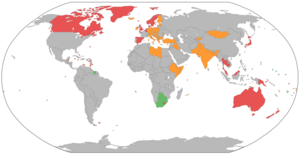Parliamentary republic facts for kids

A parliamentary republic is a type of government where the people choose their leaders. It's a system used in many countries around the world. In this system, the people vote for representatives who then choose the main leader of the country.
Contents
What is a Parliamentary Republic?
In a parliamentary system, there are two main parts of government:
- The legislature (or parliament) is the group that makes laws.
- The executive is the part of government that carries out and enforces these laws.
In a parliamentary republic, the people choose the members of the legislature through elections. This means the lawmakers get their power from the people. Then, the executive leaders get their power from the legislature. So, the people are the ultimate source of power in this type of government.
How Leaders Are Chosen
The people vote for many individuals to become members of the legislature. This group of elected people then comes together to choose one person to be their main leader. This leader is often a member of the legislature themselves. In most countries, this important job is called the Prime Minister. The Prime Minister is the head of government and leads the country.
This way of choosing leaders is different from other systems. For example, in some other parliamentary systems, members might be chosen by a head of state, local leaders, or even by birth. But in a parliamentary republic, the people directly choose the members of parliament. They do this by voting for politicians in their area or for a political party. The politicians they elect then go to parliament to create laws and select the head of government. This gives the people a lot of power in deciding who runs their country.
Countries with a Parliamentary Republic
| Country | Parliamentary republic adopted |
|---|---|
| 1991 | |
| 1991 | |
| 1991 | |
| 1966 | |
| 1989 | |
| 1990 | |
| 2000 | |
| 1993 | |
| 1978 | |
| 1999 | |
| 1991 | |
| 1991 | |
| 1919 | |
| 1949 | |
| 1975 | |
| 1990 | |
| 1944 | |
| 1950 | |
| 2005 | |
| 1949 | |
| 1948 | |
| 1946 | |
| 1979 | |
| 2010 | |
| 1991 | |
| 1941 | |
| 2012 | |
| 1991 | |
| 1991 | |
| 1974 | |
| 1979 | |
| 1992 | |
| 1986 | |
| 1994 | |
| 1949 | |
| 1992 | |
| 1968 | |
| 2008 | |
| 2010 | |
| 1990 | |
| 2007 | |
| 1291 | |
| 1991 | |
| 1995 | |
| 1993 | |
| 1991 | |
| 2012 | |
| 1961 | |
| 1848 | |
| 1976 | |
| 1946 | |
| 1980 |
See also
 In Spanish: República parlamentaria para niños
In Spanish: República parlamentaria para niños

